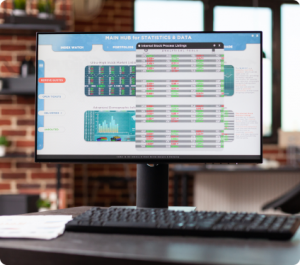What exactly is workflow automation, and how can it benefit your organization? Read on for the complete insights.
What is Workflow Automation?
Workflow automation is the process of using technology to perform processes, which have been arranged in a sequence of tasks called a workflow, with little to no human intervention. It involves creating a series of automated actions that are triggered based on specific conditions or events, streamlining complex business processes and reducing the need for manual input. Workflow automation can be applied to various functions within your organization, from simple administrative tasks to complex, multi-step processes.
What is a workflow?
To understand workflow automation, it’s essential to first grasp what a workflow is.
A workflow is a sequence of tasks that are performed in a specific order to achieve a particular outcome. These tasks can involve multiple people, systems, processes and departments within your organization.
For example, consider the process of purchasing an asset in a company. The workflow might look something like this:
- Employee submits a purchase request.
- The request is sent to the department manager for approval.
- Once the manager approves, the request is forwarded to the finance department for budget verification.
- After budget approval, the request goes to the procurement team for processing.
- The procurement team places the order and notifies the original requester.
In this example, each step in the workflow is dependent on the completion of the previous step. Traditionally, this process involves multiple emails, manual follow-ups, and significant time delays.
With workflow automation, each step can be automated, ensuring the process flows smoothly and efficiently from start to finish without the need for constant human involvement.
Workflow Automation vs. RPA: Are They the Same?
While workflow automation and robotic process automation (RPA) are often mentioned in the same breath, they are not the same. Understanding the distinction between the two can help you make better decisions for your workflow automation needs.
Workflow automation focuses on automating processes by creating a predefined sequence of tasks that are triggered automatically. It is typically used to streamline workflows within applications and systems that are already integrated.
On the other hand, RPA involves using software robots, or “bots,” to mimic human actions. These bots can interact with digital systems and software just as a human would, of course, with greater speed and accuracy. RPA is particularly useful for automating tasks that involve interacting with multiple, disparate systems that may not be easily integrated.
For example, if your workflow includes tasks such as copying data from emails to an internal CRM system, generating reports from various software platforms, or performing data entry, RPA can be employed to handle these tasks efficiently. The bots can log into applications, enter data, and perform repetitive actions without errors, freeing up your employees to focus on more valuable work.
In essence, while both workflow automation and RPA aim to improve efficiency and productivity, they do so in slightly different ways. Workflow automation is ideal for streamlining processes within integrated systems, whereas RPA excels at automating tasks across multiple, non-integrated systems.
By combining these, you can achieve a higher level of operational efficiency and unlock new opportunities for growth and innovation within your organization.
Why is Workflow Automation Important? 12 Benefits You Can Expect
Workflow automation can be a significant pivot for businesses aiming to enhance efficiency, reduce costs, and improve overall productivity. Here are 12 key benefits of implementing workflow automation in your organization:
- Increased efficiency: Workflow automation reduces the time taken to complete tasks by eliminating manual intervention. Processes that took hours or days can be completed in minutes.
- Consistency and accuracy: Automated workflows ensure that tasks are performed consistently every time, reducing the risk of human error and increasing the accuracy of outputs.
- Cost savings: By automating repetitive workflows, you can significantly reduce labor costs and operational expenses, leading to substantial savings over time.
- Improved productivity: With routine workflows automated, your employees can focus on higher-value activities, boosting overall productivity and job satisfaction.
- Better compliance: Automated workflows ensure that processes adhere to regulatory and compliance requirements, reducing the risk of non-compliance and associated penalties.
- Enhanced collaboration: Workflow automation facilitates better communication and collaboration among team members by providing clear, streamlined processes.
- Scalability: Automated workflows can easily be scaled to accommodate growing business needs without a proportional increase in workload or complexity.
- Transparency and accountability: It provides a clear audit trail, making it easy to track the progress of tasks and hold team members accountable for their responsibilities.
- Faster decision-making: Automated workflows can provide real-time data and insights, enabling faster and more informed decision-making.
- Improved customer satisfaction: By streamlining processes and reducing delays, workflow automation can lead to faster response times and improved customer service.
- Resource optimization: Workflow automation helps in better allocation and utilization of resources, ensuring that human and financial resources are used most effectively.
- Innovation and growth: With routine tasks automated, your organization can dedicate more time and resources to innovation and strategic growth initiatives.
How to Create a Workflow Automation? Step-by-Step Guide
Implementing workflow automation in your organization may seem daunting – but with a structured approach, you can transform your workflows for the better. Here is a step-by-step guide to help you get started:
1. Identify the workflow to automate
Start by selecting a workflow that is repetitive, time-consuming, and prone to errors. Prioritize workflows that will have the most significant impact on efficiency and productivity.
2. Define the goals and objectives
Clearly outline what you aim to achieve with workflow automation. This could include reducing processing time, improving accuracy, or enhancing customer satisfaction.
3. Map out the workflow
Create a detailed flowchart of the current processes, identifying each step, the stakeholders involved, and the decision points. This will help you understand the workflow and identify areas for improvement.
4. Choose the right automation tool
Select a workflow automation tool that suits your organization’s needs. Consider factors such as ease of use, integration capabilities, scalability, and cost. Popular tools include Zapier, Microsoft Power Automate, and Nintex. You can also opt for end-to-end software like JIFFY.ai that doesn’t involve any coding or complex configuration.
5. Design the automated workflow
Using the chosen tool, design the automated workflow by defining triggers, actions, and conditions. Triggers are events that start the automation, actions are the tasks performed, and conditions determine the workflow’s path based on specific criteria.
6. Test the automated workflow
Before full deployment, test the automated workflow with a small group of users. Identify any issues or bottlenecks and refine the process as needed.
7. Train your team
Ensure that your team is adequately trained on the new automated workflow. Provide comprehensive training sessions and create documentation to help them understand and adapt to the changes.
8. Deploy the workflow automation
Once testing is complete and your team is trained, deploy the automated workflow across the organization. Monitor the implementation closely to address any issues that arise.
9. Monitor and evaluate performance
Continuously monitor the performance of the automated workflow to ensure it meets the defined goals and objectives. Use analytics and reporting tools to track key performance indicators (KPIs) and make necessary adjustments.
10. Gather feedback
Collect feedback from users to identify any areas for improvement. This feedback is crucial for refining the workflow and ensuring it meets the needs of your organization.
11. Iterate and improve
Workflow automation is not a one-time project but an ongoing process. Continuously seek opportunities to improve and optimize your automated workflows to adapt to changing business needs and technologies.
12. Document the process
Maintain thorough documentation of the automated workflow, including the design, implementation, and performance metrics. This documentation will be valuable for training new employees and for future reference.
Examples of Workflow Automation to Inspire You
To help you envision the potential of workflow automation, here are a couple of real-world examples that demonstrate its impact across different industries:
Example 1: Customer support automation
Industry: E-commerce
Imagine an e-commerce company that’s struggling with high volumes of customer support inquiries, leading to delayed response times and dissatisfied customers.
The company can implement a workflow automation system to manage customer support tickets. When a customer submits a support request, the system automatically categorizes the inquiry based on keywords and routes it to the appropriate support team. If the issue is common, an automated response with relevant information is sent immediately. More complex issues are flagged for human intervention.
Example 2: Invoice processing automation
Industry: Manufacturing
Let’s say a manufacturing company is experiencing delays and errors in its invoice processing system, which relies heavily on manual data entry and paper-based workflows.
The company can replace this antiquated system with an automated workflow for invoice processing. When an invoice is received, it is scanned and digitized. The automated system extracts relevant data, validates it against purchase orders, and routes it for approval. Once approved, the payment is processed, and the records are updated in the accounting system.
Are You Aware of These Workflow Automation Challenges?
While workflow automation offers numerous benefits, it’s not without its challenges. Understanding these potential pitfalls can help you navigate the rollout more effectively and maximize the benefits for your organization.
1. Resistance to change
One of the most significant challenges is resistance from employees who are accustomed to traditional workflows. Change can be daunting, and without proper communication and training, your team might resist adopting new automated workflows. To mitigate this, involve employees early in the decision-making process, provide comprehensive training, and highlight the benefits of automation for their daily workflows.
2. High initial costs
Implementing workflow automation can require a substantial upfront investment in software, infrastructure, and training. However, these costs are often offset by long-term savings and efficiency gains. Conduct a thorough cost-benefit analysis to ensure that the investment aligns with your business objectives.
3. Complexity of integration
Integrating automation tools with existing systems can be complex, particularly if your organization uses a variety of disparate software applications. Ensure that the automation solution you choose is compatible with your existing systems and can seamlessly integrate without disrupting current workflows.
4. Data security and compliance
Automating workflows often involves handling sensitive data. Ensuring data security and compliance with regulations such as GDPR or HIPAA is crucial. Choose automation tools that offer robust security features and comply with relevant regulations to protect your data.
5. Loss of flexibility
Your current workflows may be highly efficient for repetitive tasks, but they can lack the flexibility to handle unique or unexpected scenarios. Design workflows with built-in contingencies and allow for human intervention when necessary to address non-standard situations.
How Workflow Automation Software Can Help
Despite these challenges, the right workflow automation software can significantly enhance your business operations. For instance, these software tools often come with powerful integration capabilities, allowing you to connect various applications and systems effortlessly. Look for solutions that offer pre-built connectors and APIs to facilitate seamless integration.
Also, many tools are designed with user-friendly interfaces that make it easy for non-technical users to create and manage workflows. Drag-and-drop builders, templates, and intuitive dashboards enable your team to set up and modify workflows without extensive technical knowledge.
Packed with collaboration features – such as shared workspaces, real-time notifications, and activity tracking – these tools foster better communication and coordination among team members.
Finally, to continually improve your workflows, it’s essential to access detailed analytics and reporting. Automation software can provide insights into process performance, identify bottlenecks, and highlight areas for improvement. And make sure that the software you choose has strong security measures to protect your sensitive information.
What is the Future of Workflow Automation?
Workflow automation technology is fast evolving. Artificial intelligence (AI) and machine learning (ML) are poised to revolutionize workflows. They enable more intelligent and adaptive workflows that can learn from data, predict outcomes, and make decisions with minimal human intervention.
Hyperautomation uses advanced tools like AI, ML, RPA, NLP and process mining to automate as many business processes as possible. It’s about integrating multiple automation tools to create end-to-end automated solutions that drive unprecedented efficiency and innovation.
The rise of no-code and low-code platforms is also democratizing workflow automation. AI-powered platforms like JIFFY.ai enable faster deployment and greater flexibility, empowering your team to adapt to changing business needs quickly.
As technology continues to evolve, workflow automation will become even more integral to your business operations – driving innovation and growth. Talk to our experts to know more.




